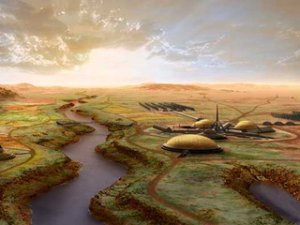

I’ll give you three guesses to figure out which continent this picture is centered on.
Nope, it’s not Africa, nor Europe. You’re not looking at the Americas or Asia either. This is actually Mars; specifically, this is an artist’s conception of what a terraformed Mars might look like, turning our favorite red dot into a blue one.
Humans have evolved to breathe a very specific type of air, Earth air. This special sauce is comprised of a mixture of nitrogen, oxygen and carbon dioxide (with bits of other elements thrown into the mix). Unlike what you see in science-fiction, if you stepped through a Stargate, or beamed down to the surface of another planet from the Enterprise, chances are you’d start to suffocate. Furthermore; it doesn’t really matter how ‘Earth-like’ the world is; the air is just wrong, it isn’t home. So, as humanity branches out into our solar system and (hopefully) beyond, how will we live on these other worlds? There are two options open to us: we can either build biospheres, or terraform the entire planet.
A biosphere is great for outposts and getting a colony started; it’s an enclosed structure within which we can live – similar to the International Space Station. Of course, as the population grows, so must the biosphere; this brings us to option #2 for human living: terraforming.
Terraforming literally means “Earth-shaping” and it is the process of deliberately shaping another world to make it suitable for human living. This will likely involve changing this world’s atmosphere, ecology, temperature, and topography, among many other things. So, what would be involved in the ‘easy’ task of changing the environment of an entire planet? Let’s use Mars as an example.

Note: At this point, it is important to realize that terraforming is a hypothetical process. Scientists don’t even know if such a procedure is possible (at the least, it would be extremely difficult to accomplish.)
So, what type of changes would Mars need undergo in order for it to be habitable? Martyn Fogg talked about five critical changes Mars must undergo in his text “Terraforming: Engineering Planetary Environments.” They are as follows:
- The surface temperature must be raised.
- The atmospheric pressure must be increased.
- The chemical composition of the atmosphere must be changed.
- The surface must be made wet (preferably with water)
- The surface flux of UV radiation must be reduced (exposure to a high level of UV radiation is EXTREMELY detrimental to humans)
Fortunately, in the case of Mars, many of the necessities are already present. We just need to develop a method of capitalizing on the substances to make them suit our purposes. To start with, Mars already has an abundance of water ice frozen beneath the surface (melting the water ice would give mars a planet-wide ocean about 11 meters deep). It also has frozen carbon dioxide (or dry ice). If we were able to melt the frozen carbon dioxide, it would help increase atmospheric pressure – thus triggering a runaway greenhouse effect (This greenhouse effect would raise the temperatures globally). Of course, saying you want to melt the Martian poles and actually doing so are two entirely different things.
Several different methods have been proposed to help melt the permafrost. These methods range from spreading black material throughout the Polar Regions, to detonating nuclear bombs. Orbiting mirrors are another – more recent – suggestion, which many scientists find promising. I, personally (among many other scientists), find the mirrors the best alternative – mainly because they would be a long-term source of heat. To keep Mars warm enough for habitation, we would need to direct more of the suns energy at the planet; these mirrors help solve that problem.

Activating the Martian hydrosphere is another issue to be contended. Again, we have several solutions for this; from blasting Martian permafrost with nuclear devices, to directing an asteroid at the Martian polls in an extremely precise fashion. Again, these issues are potentially solved by orbiting mirrors.
At this point (assuming all goes according to plan), Mars would become habitable for microbial life, though the constant bombardment of ultraviolet radiation means we’d need to introduce some resilient little critters to a remedial ecosystem – such as lichen. The byproduct of their activity is the release of oxygen, which in turn, will also help build an ozone layer. In concert with this, the last major step to a habitable Mars would be the introduction of nitrogen into the atmosphere. Mars already has nitrogen stored in mineral form in the regolith (its regolith is made up primarily of iron oxide – a main component of rust, which gives Mars’ its infamous red hue). Breaking that up for release into the Martian atmosphere would require a tremendous amount of energy. In contrast, we could artificially introduce nitrogen into the Martian environment; one such method includes redirecting an ammonia rich asteroid to our proverbial reddish-blue friend.
Finally, we come to the hypothetical point where a human could step onto the surface and take a nice deep breath of fresh Martian air. Of course, because Mars is geologically inactive, so unless we could reignite plate tectonics (or liquefy Mars’ core), we would need to continuously maintain the Martian atmosphere and keep it at livable levels (but, this maintenance would occur once every few centuries).
All of this is assuming that it is possible to not only terraform another world, but to fine-tune it enough for human habitability. Even then, as genetic engineering gets more advanced, we could fine tune humans to live on the surface of the fourth planet from the sun.
Assuming it’s possible to terraform a planet to support humans from Earth (non-genetically modified humans that is), how cool would it be to step off of that spaceship and take a breath of fresh alien air?
